When I saw Reservoir Dogs, I was blown away. The film seemed so simple — a traditional heist story, but the dialogue and the editing felt fresh and groundbreaking. Quentin Tarantino’s next three or four movies gave me the same impression. Everyone knows Tarantino is a fan of movies. He takes a long time to perfect his films and seems to have all creative control of them. Knowing this, I feel comfortable assuming that every shot, every bit of everything is intentional. After four years, Once Upon a Time… in Hollywood was released. Would this be Tarantino’s great homage to westerns? Is it a docudrama of the Manson murders? Somehow, it is both and it is long. It runs almost three hours, which is par for Tarantino. But this was the first Tarantino movie that actually felt long. And pretty complicated… for a few reasons.

Women
While Brad Pitt’s character, Cliff Booth, is a likable quasi-hero, there is a running rumor within the film about his participation in his wife’s death. We are given a flashback to his wife on a boat complaining like a banshee and Cliff with a harpoon in his hand. However, the flashback does not give the audience the full story — it cuts before we see what really happened to her. We, the audience, and the characters in the film do not know if he actually murdered her. This rumor (just a rumor — no proof either way) is hurting Cliff’s career as a stuntman. Could this be a subtle criticism of the #MeToo movement and the rise of accusations made against men in Hollywood? Wendy Idle saw the same connection in her review of this film for The Guardian. She writes, “Tarantino’s decision to engineer audience support and sympathy for a character whose career has stalled because of allegations of violence against a woman feels like a deliberate provocation and a petulant dig at the #MeToo movement.” Should the audience believe Cliff? To my recollection, he does not deny it, but we don’t know for sure, and we’re supposed to see him as the good guy. Whether Tarantino intended to throw shade at #MeToo or not, the addition of this murder mystery was directly comparable to the movement.
Beyond the rumor and possible #MeToo relationship, the women in the film are not as complex or developed as the men. Sharon Tate is the main female character. She is sweet, simple, and nice to look at. In a scene where some party-goers are explaining the relationships between Roman Polanski, Sharon Tate, and Jay Sebring, a woman says, “Sharon absolutely has a type: cute, short, talented guys who look like 12-year-old boys.” What about Polanski?! While this film is set in a time before the accusation that Polanski drugged and raped a teen girl, it was an uncomfortable choice for this film. Sharon has a weird, inappropriate type? At least she is dealing with adult males and not actual 12-year-olds. If Tarantino included this purposefully as a joke or wink to the Polanski accusations, it was offensive to put that on the female lead.

Bruce Lee and Mexican Stereotypes
The character of Bruce Lee has been the source of debate in many reviews of this film. Even going into the film with an open mind about the Lee character will ultimately disappoint. Bruce Lee is the only person of color with any real dialogue in the film, so it was upsetting to see Lee used as cheap comic relief and just a tool to prove that Cliff is a badass. Some articles cite that Lee was actually pompous, and he might have even said something about knocking out Muhammad Ali. Either way, Lee was portrayed as a one-dimensional character in the film. While in the theater, I was uncomfortable at the audience’s laughter (the most I heard during the entire film) when Lee was fighting Cliff. It was the same reaction I had when I heard the audience laugh in The Hateful Eight when the n-word was first used.
However, none of the actors in the film are shown in the best light. Is the reasoning behind the obnoxiousness of the Lee role to demystify actors? That might be a stretch. Even if it is true, it was a problematic representation of the only speaking role from a non-white person. Some extras on the set of one of the films within the film are Mexican. They are unnamed, without dialogue, and meant to be Sancho Panza stereotypes. I can acknowledge the typical representation of Mexicans in 1960’s Western films was not well-rounded. But it is 2019 and, again, problems arise because of the negative stereotypes in the film’s tiny amount of representation.

When we finally get to accompany Cliff to the Manson Family ranch, we learn that the hippies are eerie, but are not lying to Cliff. Cliff confirms everything that the hippies have told him to be true. Even in the final scenes, the hippies’ motivation is to kill the people who taught them to kill: actors in violent movies. The glaring omission was that Charles Manson’s goal was actually to start a race war. He even carved a swastika on this forehead! It wasn’t all peace, love, and LSD — it was much, much darker. The racism of the group and their true intentions were completely ignored in this version.
Conclusion
Part of the fun when watching Tarantino films is to find all of the references he includes. Usually, he is copying the style of DePalma or Leone, or using obscure but wonderful music. Once Upon a Time… in Hollywood seems to be filled with references. For a list of most of them, see a reference guide here. To me, the most noticeable references were self-references.
Cliff Booth was a typical Samuel L. Jackson role. Even one of Cliff’s lines seemed so familiar: “If something were to happen to my boss’s car, well, I’d get in trouble.” This was a line that Jules Winnfield would say. All of the cars were throwbacks to previous films like Pulp Fiction and Kill Bill.

As usual, Tarantino’s worlds collide through the actors. A major character in Once Upon a Time… in Hollywood is Kurt Russell as the stuntman coordinator on the film set. Russell also played Stuntman Mike in Death Proof. Instead of seeing the usual suspects like Bruce Willis and Uma Thurman, we meet their real-life children, Rumer Willis and Maya Hawke. Obviously, Pitt and DiCaprio have previously starred in Tarantino movies as well.
Tarantino’s originality just feels standard in this ninth film. The self-referencing is fun to see, but the obviousness and large quantity move toward egocentric. The audience is subjected to the standard portrayal of violence for a Tarantino film; it was shocking and lasted an uncomfortably long time. In Once Upon a Time… in Hollywood, the most violent scenes are the release for the audience — the payoff after two and a half hours of anticipation. This alternative history, unfortunately, maintained the gender and race stereotypes of the 60’s, only fictionalizing the white male hero. Was this Tarantino’s Leone western? I liked the Kill Bill 2 scenes with Michael Madsen better. Overall, this isn’t Tarantino at his best.
(Note: This article was originally published by Sarah Erskine on Medium.)

Comments